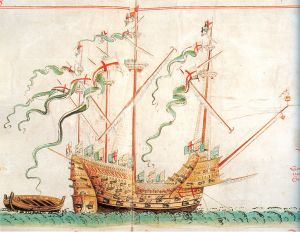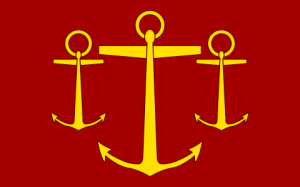A few days ago, a friend was arguing how anyone interested in history needed to know about the military to really understand history. It is a fair enough argument, but though many aren’t that interested in wars (mainly, myself), I still find the administration, finance and politics of navies and armies intriguing enough to write this post.
A lot is always talked about how Henry revitalised the navy and made England fit to be a naval power. We also know that Elizabeth’s success with the Armada was partly due to Henry’s interest in building a modernised navy. During his reign, plenty of money was poured into ship-building, devising naval strategies, buttressing up coastal defences and building of a navy. Henry inherited a total of just six warships when he took the throne, and he left 57 warships to his heir, along with 15 galleys or smaller ships.
Some of Henry’s more famous ships are:
Henri Grace à Dieu – Named after our very own king, and also known as Great Harry, this huge ship could carry a crew of 1536 sailors. Built in 1525, this was a vanity and prestige project, and was undertaken to strengthen the image of the English Navy. This namesake of the King accompanied him to the ostensible display of the Field of the Cloth of Gold. The cost of maintaining this ship was immense, but it probably served to enhance and encourage the navy.
Henry was very fond of this ship and often travelled in it for show. It was richly decorated and presented an impressive sight to onlookers. He also threw a magnificent christening party for the ship which seems to have outdone all other ceremonials.
Nothing pleased him better than to be afloat, inspecting the progress of his ships and docks. Dressed in cloth of gold and conveyed in a barge as richly gilded as himself, he would pass down the river and up again, blowing upon his whistle, or boatswain’s call, “as loudly as upon a trumpet.” – From BIO
The Sovereign – Another ship inherited from his father, Henry rebuilt it in 1509 and was one of the first ships fortified by Henry. The ship saw action in the war with France in 1512, but afterwards it was neglected and was only found 400 years later in 1912, just before another great war.
The Regent – This ship was built in 1488 but was one of the biggest, richest and most powerful ships in the Tudor navy. It carried 225 guns and saw battle with the French, just like The Sovereign. However, this ship perished in battle and blew up into a ball of fire, taking along with it, two of Henry’s bosom friends, Sir Thomas Knyvet and Sir John Carew. There is no record of how Henry bore this loss, but according to Wolsey, he bore it stoically.
And of course,
The Mary Rose – One of the most famous ship from Tudor times, the ship also saw battle in 1513 against France and in 1514 against Scotland, and then again in 1545 against France. Quite the busy ship! However, in Henry’s last battle against France, it simply overturned and sank, partly due to windy weather and partly due to carelessness of the crew. It took down its 700 odd sailors.
You can find a lot more information on The Mary Rose in the Mary Rose website and their Facebook page. The shipwreck was discovered in 1970 and since then, the Mary Rose trust has done immense work in finding, analysing and conveying information on the ship and life in the Tudor navy.
Even with all these magnificent new ships, the navy still had to do what they had always done – rent ships from mercenaries during times of war. This was in tune with the country not having a full standing army – or navy. Most of the ships were built on the bank of the Thames River, from where it would have been easy for Henry to go and inspect the ships.
The first Tudor king introduced guns and artillery in the ships, but it was Henry VIII who was the first to build ships with platforms for the weaponry, making it easy to use and more effective than ever before. The most important development in Henry’s reign with respect to the navy was the development of gun ports, which are orifices in the hull of the ship that could be closed and opened at will, where weapons can be mounted for firing. These weapons are mounted on a gun deck, and makes life easier for the sailors in a war.
Before the building of Henri Grace à Dieu, the usual naval technique was to have archers on board for firing at the enemy and even hand to hand combat as and when the ship was able to pull across the enemy ship. With the building of this ship with its huge load of guns and cannons, that became outdated. While archers were still important and were not immediately dispensed with, the use of gunships made war just that little bit more efficient.
When not at war, the ships were generally kept in the port and only a small Winter Guard was kept sailing to protect the coasts. Henry’s strategy was to build a few huge ships to enhance the navy’s image and a lot of smaller ships to support the bigger ships in war. Some of the smaller ships were also assigned patrol, piracy checking and inshore duties and accordingly fitted out.
Other things that Henry did for the Navy:
- He built the first ever naval dock in England in Portsmouth.
- Henry took the initiative to set up a Navy Board, which was responsible for the everyday organisation of the big navy he was gradually building up.
- To work alongside the Navy Board, Henry also set up an Office of Admiralty, which was responsible for looking after building, repairs and sending of supplies to warships in war time and in peace.
Sources:
Angus Konstam: Tudor Warships – Henry VIII’s Navy
British History Online: Survey of London Monograph 14: The Queen’s House, Greenwich
Derek Wilson: Henry VIII – Reformer and Tyrant



I am slightly more interested in knowing why did Henry start with the navy building. Usually its not just a random decision but either “thought out” or “forced into”. That is the sort of background history I find a lot more interesting than the deary familial politics of Kings and their minions. 😛
Henry built the Great Harry because James of Scotland had recently built the biggest ever warship called Great Michael. Henry wanted to outshine him. Also, he went to war with France a couple of years after he came into power. So building a navy must have seemed the practical thing to do.
Different people are interested in different kinds of history. I personally find war not that interesting and enjoy learning more about interpersonal relationships and daily lifestyle of historical people.
England is an island race so I imagine Henry would have seen the importance of a good navy for defence.
I had not heard of the ship The Regent -was Sir John Carew related to George Carew the captain who went down with The Mary Rose?
I am sure they were. There seems to have been a big Carew family in good posts.
Like you I’m not that interested in military history or war. But lately I’ve been intrigued by some descriptions of battles that are down right fascinating and riveting! I guess history is history no matter what and it’s still fun to read about. Very nice post about Henry’s ships. Enjoyed it.
Glad you liked it. There are some good battle descriptions in the Henry Howard biography by Jesse Childs, if you are interested.
Thanks King Hal! I’ll look into it.
This was really interesting! I’ve recently been reading about king John’s developments of the English navy after losing Normandy, this was a great follow up for me. 🙂
Right timing, then! 😀
Perfect! It’s like you read my mind 😉
Good post — Henry’s pride in his ships reminds me a bit of moderns who are in love with cars, and it’s very interesting to see the beginnings of the modern Navy emerging. For some reason it had never occurred to me that he would have had to rent mercenary ships during wartime, though it’s consistent enough with a system where the king essentially had to whistle up various private armies and hope that their lords were feeling agreeable that day.